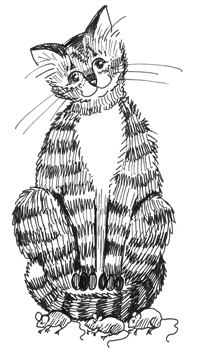STRANGE BUT TRUE- Cat-egories: Why felines just aren't into you

DRAWING BY DEBORAH DERR McCLINTOCK
Q. An estimated one-third of American households have feline members, and more than 600 million cats live among humans worldwide. Whereas other animals have been domesticated for their milk, meat, wool, or labor, cats contribute virtually nothing in the way of sustenance or work. So why have they become the most popular of pets? –J. Fariello
A. Cat domestication began in the Fertile Crescent perhaps 10,000 years ago, with the development of agriculture. Cats hung around settlements looking for food scraps and in return dispatched bothersome mice and snakes, says Carlos Driscoll in Scientific American. Plus, cats are cute, with their big eyes, snub face, and high round forehead. Thus while dogs were bred for guarding, hunting and herding, cats were under no such selective breeding pressures. "To enter our homes, they had only to evolve a people-friendly disposition."
Still, cats are far from truly domesticated, not relying on people to feed them or find them mates. The average domestic cat today is not greatly different from its wild ancestors, although with shorter legs, a smaller brain and, as Charles Darwin noted, a longer intestine, perhaps an adaptation from scavenging so many kitchen scraps. Cat breeders currently are creating exotic new breeds such as the Bengal and the Caracat (house cat crossed with the Asian leopard cat and the caracal).
"The domestic cat may thus be on the verge of an unprecedented and radical evolution whose future can only be imagined," says Driscoll.
Q. It's an exaggeration to say that Eskimos have 20 different words for "snow," but you can't hold a good Scotsman back when he wants to get bevvied, blootered, buckled, fou, guttered, legless, moroculous, mortal, pie-eyed, pished, plastered, rat-arsed, scuppered, smashed, smeekit, steaming, stocious or wrecked. That's an alphabetical listing, which for this guy may also be a bit of an exaggeration. Why? –R. Burns
A. Because the words are popular Scottish synonyms for "getting drunk," which would likely leave him in no mind or mood for alphabetizing anything, says Mark Denny in Froth! The Science of Beer.
Q. Any chance Mom or Dad caught your very first smile on camera? Dream on. –E. Kodak
A. Embryologists have spotted eye movements in fetuses only 20 weeks old, suggesting a REM-like state (the rapid eye movements of dreaming sleep) before they're born, says Harvard's J. Allan Hobson in Dreaming as Delirium.
A fascinating possibility is these fetal dreams are trial runs for behaviors to come, as brain circuits are laid out and blueprinted in utero. So it's likely your first smiles were fetal smiles, or if not there, while you were REMing away in your bassinet, unseen by loving eyes.
The human fetus spends most of its last uterine days in a REM-like state, mentally rehearsing for the world ahead. Not only smiles of happiness, but frowns of displeasure, grimaces of pain, and thumb-suckings to fine-tune the act of swallowing are among the many instinctual acts "preprogrammed by the self-activated brain, in REM, long before they are put to the service of survival," Hobson says.
~
Send Strange questions to brothers Bill and Rich at [email protected].
#